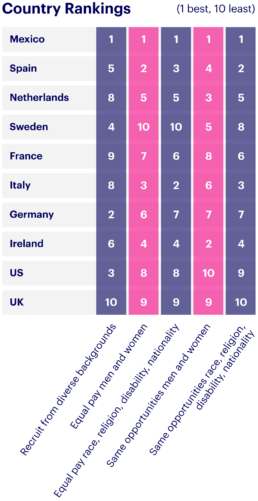“At Essity we believe that our strengths as a team lie within our differences as individuals. Building a diverse and inclusive workforce means you bring together a wider range of experiences from different situations, failures that we can learn from, successes that we can replicate, and a greater understanding of problem solving. That leads to more creativity, better decision making, and greater business success.”

Daniel Minney
VP Consumer Goods UK&ROI
The goal of this report is to identify in which parts of the world companies are generally getting diversity, equity and inclusion right from the perspective of their employees, and in which parts of the world there are opportunities to improve. By understanding this, we can begin to uncover which of the practices that are being implemented seem to be working, and what potential barriers need to be broken.
Everybody that took part in this survey did so anonymously and without naming their employer. We felt it was important to survey employees, not employers, in order to truly understand how people are feeling about diversity where they work.
For Essity, the results of this survey help us on our own journey towards creating a more diverse, equitable and inclusive workforce. As a global company, understanding the differences internationally will help inform our own decision making and cultural awareness. Our ultimate goal is to create a culture that is welcoming, caring, and thriving for everybody within our organisation.

By country
Global Diversity Rankings
Using the results of our global survey we’ve ranked each of the ten countries included on workplace diversity. We asked respondents what their employers were doing to create and support diverse workplaces: their answers show where employers are most likely to be supporting diversity – and where more work is still needed.
Chapter 1
Key Findings:Summary & Analysis
The research findings outlined in this report are based on employees’ personal views and on their perceptions of the efforts that their employers are making. The findings show a very high level of support among employees for the creation of workforces and workplaces where diversity, equity and inclusiveness are recognised, valued and protected. The extent to which employees perceive that their employers are actively doing this appears to vary by country; respondents’ views also vary by geography, gender and age; but although it is clear that almost every business could be doing more, overall the picture painted by these results is a broadly positive one.
Our findings highlight the efforts being made by thousands of businesses of all types and sizes in each of these ten countries, to increase and support diversity in the workforce and equity and inclusion in the workplace – and the extent to which those efforts are already delivering positive change.
This report reveals the following key findings:
![]() Most respondents say they work in a diverse workforce.
Most respondents say they work in a diverse workforce.
More than eight out of ten (82%) say their workforce is relatively diverse, containing people of differing ages, genders, ethnic backgrounds, nationalities and religious beliefs.
![]() More than eight out of ten respondents (83%) say it is important to them that their employer addresses diversity.
More than eight out of ten respondents (83%) say it is important to them that their employer addresses diversity.
This includes 54% for whom it is ‘very important’ (37%) or ‘vital’ (17%).
![]() Almost three-quarters of respondents (72%) say they think that their employers offer equal pay and equal opportunities for progression within the business regardless of race, religion, disability or nationality.
Almost three-quarters of respondents (72%) say they think that their employers offer equal pay and equal opportunities for progression within the business regardless of race, religion, disability or nationality.
![]() Almost two-thirds of respondents (65%) say they do not think their employer actively discriminates against employees for any of 11 possible reasons listed.
Almost two-thirds of respondents (65%) say they do not think their employer actively discriminates against employees for any of 11 possible reasons listed.
Including age, gender, race, disability, religion, or sexual orientation.
![]() In a comparison between the ten countries in the study, respondents in Mexico are most likely to say their employers have created workplaces that feel diverse; and are most likely to say that their employers have adopted policies and practices that recognise, support and promote diversity.
In a comparison between the ten countries in the study, respondents in Mexico are most likely to say their employers have created workplaces that feel diverse; and are most likely to say that their employers have adopted policies and practices that recognise, support and promote diversity.
Chapter 2
Key Findings:Statistics
Our findings reveal employers in each of these ten countries appear to be demonstrating a commitment to improving the diversity of their workforces and to promote equity and inclusiveness in workplaces, in ways that can improve their employees’ working lives, but may also, ultimately, improve productivity, decision making and profitability.
62%
of respondents say their employer actively seeks to recruit people from diverse backgrounds and with a range of personal attributes.
49%
of respondents say their employers are implementing a zero-tolerance approach to bullying, harassment and use of inappropriate language.
33%
of respondents say their employers are conducting diversity training throughout their organisations.
Chapter 3
Where are employers doing most to create workplaces that value and protect diversity?
Our results show that diversity is not just a buzzword; and that employers’ efforts to promote and support it are not just driven by a desire to improve the company’s public image. It is clear that diversity is important to a large majority of employees: more than eight out of ten respondents (83%) say it is important to them that their employer addresses diversity.
By Country (Answered Yes)
Do you currently work in what you would describe as a relatively diverse workforce?
Global
More than eight out of ten of all respondents (82%) say they work in a relatively diverse workforce: with people of differing ages, genders, ethnic backgrounds, nationalities and religious beliefs.
There is some variation by country. In Mexico a huge majority of respondents (96%) say they work within a diverse workforce, with the next highest percentages of positive responses coming from respondents in Spain (89%). The country where the lowest percentage of respondents believe they work in a relatively diverse workforce is the UK – yet even there seven out of ten people say this is the case.
Perceptions of employers’ efforts to support diversity in their workforce, and equity and inclusion in the workplace
Equal Pay
72%
of respondents say they believe their employer offers equal pay for jobs regardless of race, religion, disability or nationality.
66%
say they believe their employer offers equal pay for men and women performing the same roles.
71% of male respondents think their employer offers equal pay, while only 62% of female respondents think this is the case. 20% of women say they don’t know either way, compared to only 14% of men – an indication, perhaps, of a need for transparency, as well as fairness, around equal pay policies.
Mexico is the country where the most respondents say they think their employer provides equal pay for men and women (82%); and equal pay regardless of race, religion, disability or nationality (86%).
Equal Opportunities
72%
believe their employer offers equal opportunities for progression within the company regardless of race, religion, disability or nationality. 12% say they do not think their employer does this.
62%
of respondents say they think their employer actively seeks to recruit people from diverse backgrounds and with a range of personal attributes.
Younger people are more likely to think that men get more opportunities for progression within their organisation: 21% of those aged 18 to 24 think this is the case, compared to 18% of those aged 25 to 34, 17% of those aged 35 to 44; and 11% of those aged 45 and over.
Does your employer off men more opportunities for progression?
By Age Range (Answered Yes)
Mexico is the country in our study where you are most likely to find a diverse workforce and a workplace where equity and inclusion are actively supported
If we take the percentages of positive responses received to 14 of the questions we asked, then use them to create a league table for the countries covered by our research, Mexico comes out on top. Respondents in Mexico provided the highest percentage of affirmative answers in six out of 14 categories; and the second or third highest percentage of positive responses in five more.
The UK is at the bottom of this league table, with the lowest positive percentages in four categories. But even in the UK a majority of respondents give their employers positive scores in seven categories, including equal pay for men and women (60%), equal pay regardless of race, religion, disability or nationality (65%); and equal opportunities for progression regardless of race, religion, disability or nationality (62%). It is also important to remember that these responses are based on employees’ perceptions, which may themselves be influenced by cultural norms, or a greater level of awareness of certain issues within that country.


Progress being made
The results of our survey clearly show the progress that is already being made in all ten of these countries towards increasing diversity within the workforce and improving support for equity and inclusion within workplaces. But they also show that there is still significant room for improvement.
Chapter 4
Room for Improvement
Almost two-thirds of respondents (65%) say they do not think their employer actively discriminates against anyone for any of these reasons. Nonetheless, this is clearly an area where further improvement is needed.
About three out of ten respondents say they think their employer actively discriminates against some employees on the basis of at least one of 11 characteristics listed in our study, although only in the case of one characteristic – age – does the percentage of respondents reporting discrimination reach double figures (12%).
Do you think your employer actively discriminates against anyone in terms of recruitment, pay rises, promotions, job roles, training or anything else?
Do you think your employer actively discriminates against specific individuals due to their background or personal characteristics?
Among respondents who think their employer sometimes discriminates, they believe the way in which employees are most likely to suffer is in relation to pay rises, cited by 28% of this group.
More than one in four of respondents who report discrimination in their workplaces say it occurs in recruitment, is visible in the roles individuals were chosen to fill; and in promotions and employee progression. 23% of this group have seen discrimination displayed via treatment of employees within the office, including bullying.
Personal experience of discrimination
A large majority of respondents (61%) say they have not experienced discrimination themselves in relation to any of 17 possible reasons we listed. Respondents in the UK are least likely to report having been discriminated against, with 69% selecting the ‘None of the above’ response.
Top areas where people are discriminated against
9%
Asking for a pay rise
9%
Needing flexible working hours
7%
Applying for a promotion
7%
Leaving work for children
- Taking time off for mental health
7% - Physical appearance6%
- Maternity or paternity leave5%
- Dressing in a certain way5%
- Requiring certain food5%
- Time off for religious event5%
- Needing somewhere to express breastmilk4%
- Gender neutral pronouns4%
- Praying during the day4%
- Not using gender specific bathrooms4%
- Disability4%
- Race4%
- Religious beliefs4%
Across all ten countries no more than 4% of respondents report discrimination against them personally on the grounds of disability, race or religious belief. But of course, even these relatively low figures still represent an unacceptably high incidence of discrimination.
A broadly positive, but still mixed picture
While the overall results of our research show a broadly positive picture of support for diversity, equity and inclusion there are also clearly opportunities for employers within each country to improve their record in relation to the 14 areas about which we questioned respondents.
For example, while the US was a strong performer in general, holding fourth place in our overall league table, respondents there were least likely to say their employers offered equal opportunities for men and women to progress within the organisation: 41% said this was the case, compared to an average of 60% across the ten countries. Respondents in the US were also most likely to say they have suffered discrimination personally in the workplace.
Our results also suggest there is room for improvement in supporting diversity among UK employers, with UK respondents providing the lowest number of positive responses for recruiting from diverse backgrounds and for providing the same opportunities for progression regardless of race, religion, disability or nationality. But even here it is worth noting that almost two-thirds of UK respondents say their employer offers equal pay regardless of race, religion, disability or nationality.
But comparing country to country in this way may also ignore some nuances created by cultural and in some cases even legal differences between them. Within every country there will also be some employers who are not yet doing very much at all to recognise, protect or promote diversity, equity and inclusion– and others who are doing so in exemplary fashion.
So in order to try to discover in a little more detail exactly employers’ performance, we also asked respondents about the policies and practices their employers have implemented in an attempt to support and promote diversity, equity and inclusivity.
Chapter 5
Policies & Practices for Diversity
Across all ten countries, the ten policies and practices that employers are most likely to have in place already are:
50%
Offer everyone in meetings the chance to contribute
49%
Zero-tolerance policy towards bullying, harrassment etc
46%
Offer flexible working hours
45%
Improve working spaces to create a healthy environment
39%
Stocking sanitary items in bathrooms
39%
Schedule team bonding activities
38%
Make sure all company policies incorperate diversity
37%
Check the office temperature for everyone in the office
36%
Sick leave policy includes mental health days
34%
Establish a better parental leave policy
In recruitment specifically, findings drawn from respondents in all ten countries show that:
think their employer conducts diversity training throughout the organisation
believe their employer offers unconscious bias training for all recruiters and managers
think their employer highlights diversity on the company’s jobs page
think their employer posts openings on job boards that specialise in diversity
think their employer targets minority groups in recruitment
Support for employees with young children, or wanting to start a family
We asked respondents in each country whether their employers offer anything over and above the statutory minimum maternity and paternity leave.
However, minimum statutory maternity/paternity leave varies hugely from one country to another. In the US there is no requirement in Federal law for paid maternity leave and only a handful of US states mandate any paid parental leave. By contrast, the 39 weeks minimum paid maternity leave available to mothers in the UK is one of the most generous in the world (in terms of time, at least, as they are only entitled to a minimum of 30% of salary during this period).
Minimum statutory maternity leave provision in each country
Parental leave, including paternity leave, also varies by country: there is no minimum statutory allowance in the US or Ireland and provision is minimal in the UK, Italy and the Netherlands. New fathers in Mexico are entitled to five days’ paternity leave; while those in Spain, France and Germany are entitled to about five weeks. In Sweden, both parents get an allocation of 480 days to allocate between them. Parents in Germany can take up to three years unpaid parental leave between them, during the first eight years of their child’s life, with an employer’s consent.
Across all ten countries, 40% of respondents say they believe their employer provides somewhere for staff or visitors to breastfeed or express milk during the working day. The country where this is most likely to be the case is the US (58% positive responses); it is least likely to be available in the UK (22%).
Half of all respondents say they believe their employers are happy for staff to take paid leave or to work flexibly in order to attend antenatal or fertility appointments.
Most likely to provide somewhere for breastfeeding or expressing milk
Least likely to provide somewhere for breastfeeding or expressing milk
Supporting different beliefs and cultural practices
More than four out of ten respondents (42%) think their employer recognises non-Christian religious occasions, such as Eid-al-Fitr, Passover or Diwali; and allows employees to take time off to celebrate. Respondents in the US were most likely to say this (58% positive responses).
Roughly one in three respondents (32%) across all ten countries say they think their employer makes provisions for workers who have dietary requirements linked to their beliefs, religion, or background. Employers in the US appear to be most likely to do this (50%).
Percentage of employers that employees time off to celebrate non-Christian/Catholic religious occasions:
Supporting employees with disabilities or mental health issues
Just under six out of ten respondents (59%) believe their employer caters for employees with visible and invisible disabilities in the workplace. There is some variation by country, ranging from Italy, where almost three-quarters of employers do this, to Sweden and the Netherlands, where the figure is under 50%.
Do you currently work in what you would describe as a relatively diverse workforce?
By Country (Answered Yes)
Just under six out of ten respondents across the full sample say they think their employer would be happy for a member of staff to take paid sick leave in order to address issues related to their mental health.
Would your employer be happy for a member of staff to take paid sick leave to address mental health issues, if needed?
Country Rankings (Answered Yes)
(1 best, 10 least)
Other actions to support diversity
We asked respondents which of a list of other steps that employers could take to promote and support diversity in the workforce and equity and inclusion in the workplace their employer appeared to be taking. These included:
49%
Implementing a zero-tolerance approach to bullying, harassment and use of inappropriate language
45%
Improving working spaces to create a healthy working environment
38%
Ensuring all company policies and practices incorporate diversity
33%
Conducting diversity training throughout the organisation
28%
Providing support programmes for minority groups to ensure equity across all employees
26%
Creating an inclusion council, to be as diverse as possible
17%
Offering transition related care for transgender employees
Conclusion
Our approach to diversity & inclusion
Essity has created a DE&I Advisory Group for the UK and ROI. In the following video we see the first time the group met and discover the different experiences and backgrounds that each member of the group brings to the team.
We can certainly take positives from the results of this research. In almost every aspect it is clear that the majority of people working for an employer want to see more diversity and inclusivity in their place of work. And importantly, the majority of people see the value in creating a more diverse and inclusive workforce. These are critical first steps because ultimately a workforce needs to embrace change if changes that an employer makes are to take effect.
There are clear differences of opinion based on geography, age, and company size but that isn’t unexpected. Understanding these insights will help us make the right decisions at the right time and in the right markets.
There is no one-size-fits-all when it comes to diversity, equity, and inclusion. Policies that cross international borders are unlikely to bring about the progression that we are looking for. Whilst, our strategy can be consistent throughout the world, our approach on the ground will need to be tailored.
I’d like to thank the 10,000 people who took part in this survey and I look forward to providing future updates of the progress that Essity makes as we work towards our goal of creating a culture that is welcoming, caring, and thriving for everybody within our organisation.


Daniel Minney
VP Consumer Goods UK&ROI
Methodology
This research is based on independently conducted online surveys, completed on behalf of Essity by OnePoll between January 20 and February 4 2022. The total sample size was 10,000 adults, divided into 1,000 respondents per each of ten countries: France, Germany, Italy, Mexico, the Netherlands, the Republic of Ireland, Spain, Sweden, the UK and the US. Respondents work for a range of businesses, of different sizes from a handful of employees to over 1,000; and in a range of industry sectors.
References
- Statistics on differing statutory minimum maternity leave: Maternity Leave by Country 2022 (worldpopulationreview.com)




